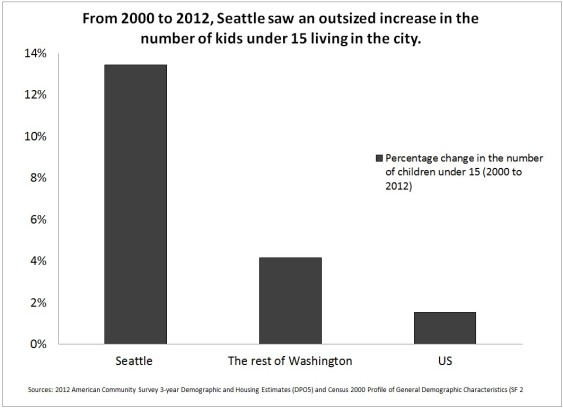Once they have kids, families move out of the city and opt for the big house, picket fence, and longer commute. That’s the story we’ve all heard. But the reality is that—at least over the last 12 years—the Northwest’s biggest cities have done a much better job of attracting and retaining kids than their suburban and rural counterparts.
Yes, it remains true that, like most other big cities, Seattle and Portland have a smaller share of kids than their suburban neighbors. In 2012, 13.5 percent of Seattle’s population was under 15, compared to nearly 20 percent for the rest of the state. In Portland, 16.4 percent of the population was under 15, compared to nearly 19 percent for the rest of Oregon. But this “child gap” has existed for decades in Seattle, and it widened the fastest during the 1960s and 1970s. Nowadays, the gap is closing.
Recently, the Northwest’s densest cities have bucked powerful demographic trends and managed to retain families with kids, something few other places have done. From 2000 to 2012, Seattle saw dramatic growth in its number of children under 15, outpacing the rest of the state and the country.

Original Sightline Institute graphic, available under our Free Use Policy.
In Portland, which has historically had more kids than Seattle, the uptick in kids under 15 isn’t as dramatic. But the city still saw a greater percentage increase than the rest of Oregon or the US. (I’ll tackle Vancouver BC and its longstanding efforts to create dense family friendly neighborhoods in a subsequent post.)

Original Sightline Institute graphic, available under our Free Use Policy.
The raw numbers don’t tell us what’s driving the trends, but it’s worth noting that Seattle’s “child gap” began to narrow around the time that growth management investments really kicked in and started channeling building to urban areas. It could be that millennial parents are starting to make their demographic mark, and that they and GenXers have different preferences than the Boomers who came before them. In a recent survey done by the American Public Transportation Association, 40% of Seattle millennials and 50% of Portland’s millennials “strongly agreed” with the statement that having kids doesn’t mean you have to move out of the city.
Whatever the underlying causes, the data certainly make intuitive sense, given the expectant parents I know searching for cribs that will fit in the closets of their Capitol Hill apartments and downtown daycares with open infant slots (harder to find than a magical unicorn!). In my own Seattle neighborhood, the new elementary school that opened four years ago to handle our local baby boom filled up so fast that there’s now a lottery to get in.
Here’s a more detailed look at the trends, showing how Bellevue, Washington, fits into the picture, which, interestingly, shows a smaller baby/toddler boom but boasts strong growth in its population of older kids. In general, the trend of expanding under-15 populations in urban areas holds true for every age class. Bear in mind, though, that part of the stratospheric growth in the under-5 population is because there were fewer children in that age group to begin.

Original Sightline Institute graphic, available under our Free Use Policy.
But here’s the truly surprising story.
At a time when larger demographic trends are driving nationwide declines in the share of the overall population under 15, Seattle has actually increased the share of its population that’s made up of kids. The recent kid trend in Seattle is practically unheard of. Take a look:

Original Sightline Institute graphic, available under our Free Use Policy.
Here’s why that’s so unusual. The combination of aging baby boomers, longer life spans, and record low birth rates means that the entire US population is skewing older. Proportionally, there are simply fewer kids. That’s why in Washington, Oregon, and the US, the under-15 share of the population contracted from 2000 to 2012—decreasing by somewhere between 8 percent and 10 percent.
Portland’s under-15 population shrank less than that, by 7 percent, and Bellevue’s declined by 5 percent. Seattle’s total share of the population under 5 actually increased, and it did so by a whopping 14 percent over the same period, while the percentage of the population that is under 15 grew by more than 2 percent.
What that means is that after adjusting for these large-scale demographic trends, those cities did a better job of retaining children and families than other areas.
There’s still much heavy lifting to be done to make the Northwest’s densest urban areas more attractive, affordable, and supportive to families with children. When you dive into the numbers a little deeper, for instance, it’s clear that Seattle and Portland are still doing a better job of holding onto their younger kids than older ones. I’ll be spending the next few months making the argument that there are many, many things we should do to make urban housing, streets, play areas, schools, transportation networks, and shared spaces work better for kids and parents.
The numbers I’ve presented here (and others) should put to rest any arguments that cities are fundamentally unattractive places to raise kids or that it’s inevitable couples will pack up for the ‘burbs once a baby arrives or kindergarten deadlines loom. In the 21st century, it’s just not true.
Notes: Demographic data in all the charts come from the 2012 American Community Survey 3-year Demographic and Housing Estimates (DPO5) and the US Census 2000 Profile of General Demographic Characteristics (SF 2).










Michael Andersen
Awesome report!
What I most want is data that would map the kid gap over time (as in Clark’s 2010 post) for a city of my choice. Is there a good place to get that old decennial Census data by age?
Jennifer Langston
Michael – I will have to do some digging to find that, since I only went back as far as 2000. The Census site has reorganized since Clark did that post and the pathways he used no longer work. Anyone else have them at the tips of their fingers?
Brie Gyncild
Those charts are pretty dramatic. Thanks for the post. Do you have the data on which neighborhoods in Seattle are seeing the most growth in the number of children, or how the demographics play out in different areas of the city?
Jennifer Langston
Brie – it’s in the works!
David Emerson Feit
Doesn’t the last chart signal a possible problem that Seattle may be having in retaining older residents? (Exactly which age/HH cohorts declined most in favor of families with children?) As we become an attractive place for families with children, we ought to take care to avoid becoming an unfriendly or unattractive home for elders. Of course, the data above show outcomes that inherently trade off one group’s presence against others, so we shouldn’t conclude anything about the underlying causes. But the last chart seems at least to raise a question about support for older residents.
Robert B
Jennifer, I think you need to re-run your analysis. You tracked percentage change in the number of kids which can be very misleading. What should be analyzed in my opinion is the percentage of the population in these areas under the age of 15. That would tell which area’s proportion of kids are moving in what direction.
By looking at the percentage of change and not the percentage of the population that are kids may not mean much. For example, if Seattle has just 10 kids but 5 new kids move in that’s 50% growth and looks outstanding but then again only 5 more kids. If the rest of the state has, say for example, 10,000 kids and only 500 kids move in then that looks like small growth- only 5% compared to my example of Seattle with 50% growth. Yet, we know that the rest of the state grew 495 kids vs. 5 for Seattle. This is purely an example but what needs to be done is to look at the percentage of folks under 15 as of the total population in question (Seattle, rest of state, etc.) over a few data points, say 2000, 2010, 2013 to get a sense as to whether things are really shifting in a meaningful way.
Clark Williams-Derry
Robert – we actually did that analysis back in 2010, and again in 2011.
What we found was that the “child gap” actually opened up in the 1960s and 1970s, with the share of kids in Seattle falling dramatically as Seattle’s suburbs grew. But in about 1980 the trends stabilized—and since 2000 the trends reversed, with the child gap between Seattle and the rest of the state narrowing.
Jennifer Langston
Robert B – that analysis you’re looking for is in the 4th chart in this blogpost. It confirms the trend.
Leila W-Oakes
This is a great article Jennifer!
You are also very accurate about this statement:
“Whatever the underlying causes, the data certainly make intuitive sense, given the expectant parents I know searching for cribs that will fit in the closets of their Capitol Hill apartments….”
I’ve actually joked about putting a crib in our closet in our studio that has a sliding door.
There’s a lot more kids under 5 living in my abuilding compared to four years ago. With festivals, urban events, increased transit connectivity, the ability to walk everywhere (built in exercise), common areas in apartment complexes and urban open space (there needs to be more commitment to dedicating park lands and public spaces in dense areas) cities are great places for children to grow up in if you are willing sacrifice space when one eventually does have children (for millenials some will have value sets that change and some may not), and has to cross that bridge.
Thanks for the read!
Jaime
Great topic Jennifer!
Kaid Benfield, in his book People Habitat, discusses “aging in place” and other aspects that are important for people of all ages in cities. He writes, “…[M]aybe the most important one related to the built environment–is to build communities that contain a variety of housing types and prices, including facilities for seniors. Another is to build neighborhoods that are safe, convenient, and interesting for all, including non-drivers and people with special needs (p. 198, People Habitat).”
Positive interactions fostered through intergenerational communities contribute to the heart of our humanity!
I look forward to reading about this :-).
~J